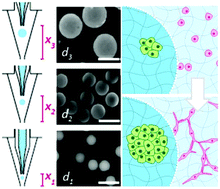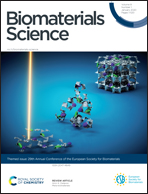Multiphasic microgel-in-gel materials to recapitulate cellular mesoenvironments in vitro†
Abstract
Multiphasic in vitro models with cross-scale heterogeneity in matrix properties and/or cellular composition can reflect the structural and compositional complexity of living tissues more faithfully, thereby creating new options for pathobiology and drug development studies. Herein, a new class of tunable microgel-in-gel materials is reported that build on a versatile platform of multifunctional poly(ethylene glycol)-heparin gel types and integrates monodisperse, cell-laden microgels within cell-laden bulk hydrogel matrices. A novel microfluidic approach was developed to enable the high-throughput fabrication of microgels of in situ adjustable diameters, stiffness, degradability and biomolecular functionalization. By choosing structure and composition of the microgel and the bulk gel compartments independently, our microgel-in-gel arrangements provide cross-scale control over tissue-mimetic features and pave the way for culture systems with designed mesoenvironmental characteristics. The potentialities of the introduced approach are exemplarily shown by creating a reductionistic in vitro model of vascularized prostate cancer tissue.

- This article is part of the themed collection: Editor’s Choice: Microfluidics


 Please wait while we load your content...
Please wait while we load your content...